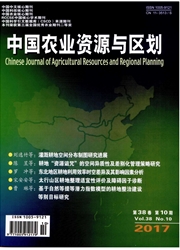

 中文摘要:
中文摘要:
[目的]黄淮海平原作为中国粮食的主产区,同时该区域水资源短缺问题日益加剧。如何在水资源可承载的条件下,保证粮食安全和经济发展,对黄淮海平原区土地利用结构的优化调整进行探索,具有重要意义。[方法]文章应用多元优化模型及遗传算法,在土地面积、宏观计划约束、粮食产量约束、市场约束等条件下,追求流域水资源平衡,同时保障粮食产量最大化,得到2020年黄淮海平原区土地利用结构优化方案,并通过土地转移矩阵,在2020年土地利用总体规划的约束下,依据2000~2010年土地利用变化路径,预测出2020年最大概率自然演化形成的土地利用结构。[结果]将最优方案与自然演化进行了土地利用结构、用水结构以及粮食产出3个方面对比,最优方案的粮食产量为8464.75万t,总耗水量减少18.56亿m~3,均优于自然演化结果,证明土地利用结构优化方案具有一定的有效性。[结论]黄淮海平原区土地利用结构优化的方向是在满足社会经济发展的情况下,尽量降低高耗水强度的建设用地面积占比,减少水资源匮乏流域的耕地面积,增加水资源较丰富流域的耕地面积,以保障粮食产量,充分利用未利用面积,增加林地、水域等生态用地的面积;优化后的土地利用结构,有效缓解了地下水水位下降的趋势。
 英文摘要:
英文摘要:
As the main producing areas in China,water shortage of Huang-Huai-Hai Plain is increasing.It is of great significance to explore the optimization of land use structure in the Huang-Huai-Hai Plain in order to ensure food security and economic development under the condition that water resources can carry.The multi-objective optimization model and genetic algorithm were used to ensure water resources balance and maximize grain yield under the constraint condition of land area,macro planning constraint,grain yield constraint and market.The optimization plan of land use structure was proposed in the Huang-Huai-Hai Plain in 2020.At the same time,the land use structure formed by the maximum probability of natural evolution in 2020 was predicted through the land transfer matrix under the constraints of the overall land use plan in 2020.The results showed that comparing optimal scheme and the natural evolution with the land use structure,water structure and grain output,the optimal grain yield was 84.67 million tons and the total water consumption was 1.85 billion m~3,which was superior to the natural evolution result.It is proved that the land use structure optimization scheme had certain validity.The direction of land use structure optimization in the Huang-Huai-Hai Plain should be to control the proportion of construction land with high water consumption intensity,make full use of the unused area such as forest land and water body,reduce the area of cultivated land in the basin with scarce water resources,and increase the area of cultivated land with abundant water resources so as to ensure the grain yield and effectively alleviate the downward trend of groundwater level.
 同期刊论文项目
同期刊论文项目
 同项目期刊论文
同项目期刊论文
 期刊信息
期刊信息
